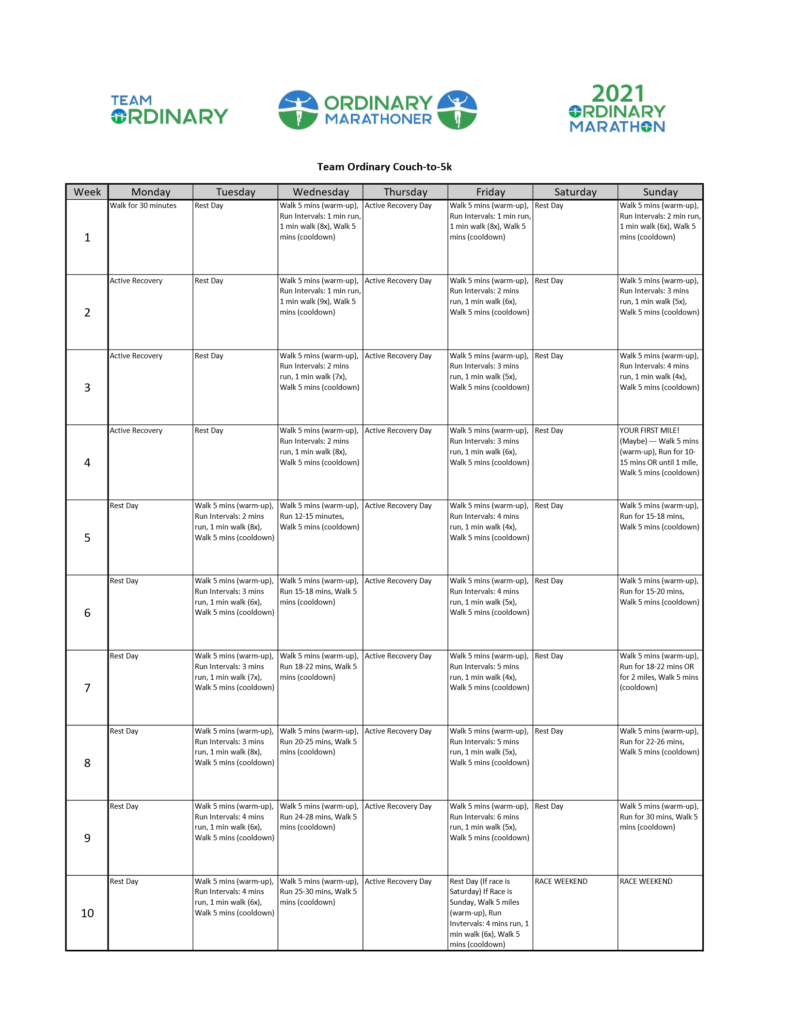Click here for the full pdf version if the image is too small.

Welcome to the Team Ordinary Couch-To-5k Training Program. This program is designed to walk you through a 10-week approach to finishing your first 5k race.
Please consult your physician before beginning any exercise regimen.
Coach Scott is available at any time, should you have any questions in regard to this plan.
HELPFUL HINTS:
Stick with the plan to the best of your ability. Missing a few days here and there or moving workouts around to fit your busy schedule is perfectly acceptable. But missing multiple days in a given week, or whole weeks at a time, may require you to repeat a week, or even retrace back to a prior week.
If you do miss some days or weeks, DO NOT QUIT! If it is your goal to complete a 5k, then pick yourself up again and get moving. You can do this!
In addition to warming-up before a run and cooling down afterwards, you should also stretch. Here is a great pre-run stretch routine you can use before and after your run.
Pay attention to any muscle aches or soreness. Injuries are common in running – from stress fractures to blisters and may get worse if you aren’t careful. Be mindful of those aches and pains, and cognizant as to whether the soreness you are experiencing may be an injury.
Always have a plan in place when you go out to run. Personal safety comes first – be mindful of areas with heavy auto traffic and no sidewalk or shoulder. Trails are often a great option. If running at night, make sure you bring a headlamp and wear reflective clothing. Bright colors also aid safety in the daytime as well.
Stay hydrated. Not only should you bring water with you on your run but try to drink throughout the day. It’s amazing what just having a water bottle near your desk that you can refill will do for your overall training.
FAQ (Frequently Asked Questions)
What is “Active Recovery”?
Active Recovery is a training day where we don’t necessarily want to go out and run. Running can be very impactful on the body. While it is important to train often, it may not always be wise (especially when first starting a routine) to subject the body to so much stress day after day after day.
Active Recovery days are designed to keep you moving and benefiting from exercise while not subjecting your body to the stresses of running. What can you do on active recovery days? You can go for a brisk walk, for one. Or you can fill in with some type of light-impact cross-training: swimming, cycling, strength training, yoga, a rower – there are all kinds of activities that can qualify as “Active Recovery.”
If I am unable to complete a run interval, what should I do?
If you find yourself running an interval and you cannot continue – due to pain or respiratory distress – stop and walk the remainder of the run interval. If possible, continue the routine to the best of your ability. Perhaps most importantly, do not get upset or dejected. Walking is perfectly acceptable, and will continue to help advance your training.
Why so many intervals?
Interval running has become more an more popular in recent years. Many people use this training method (attributed to Olympian Jeff Galloway and often called “The Galloway Method“) not just for training, but for use in racing as well!
There is no reason to be embarrassed or ashamed for stopping to walk during your training. Walking intervals will allow your body to recoup some energy so that you can stay out on the trail training longer (and smarter).
